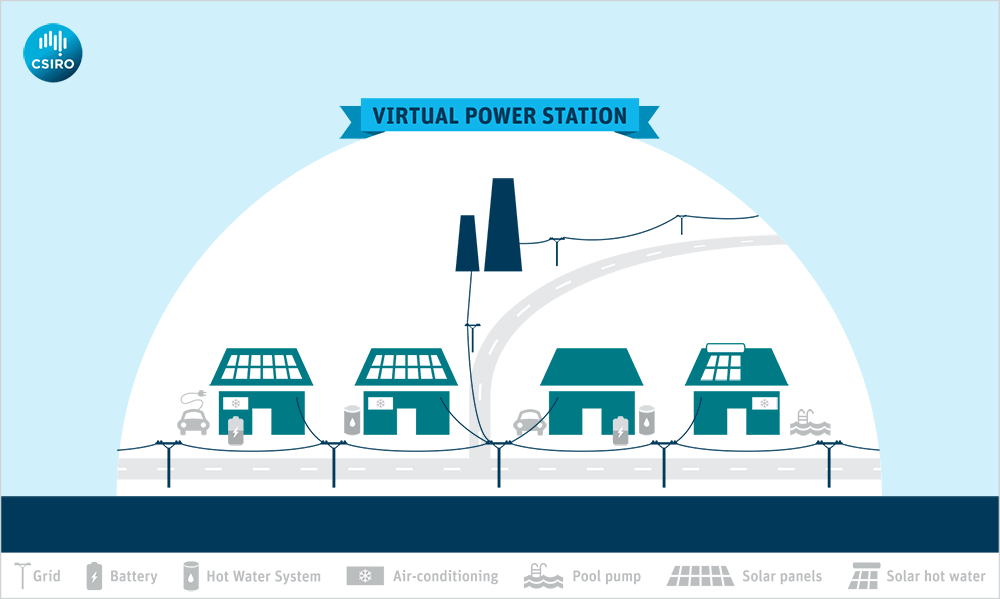As Solar Choice is currently undertaking the early stage preparations and structuring for a Virtual Power Plant (VPP) that can be made available for household, commercial and government premises across our local federal electorate of Warringah, it’s timely to look at successful VPP models elsewhere in the world.
A VPP consists of a large number of solar power and battery storage systems centrally monitored and controlled by load control systems in a web-based network, to create a single reliable energy supply that can be discharged instantly at times of peak demand, much like a gas power plant.
In addition to South Australia Govt’s own VPP initiative with Tesla that has now surpassed 1,000 participating households (as has a similar project run by AGL in South Australia), an energy retailer in the USA State of Vermont is running a VPP that is successfully delivering valuable smooth power to the grid at times of high demand.
In 2017, Vermont’s Green Mountain Power started offering residential customers a chance to own a Tesla Powerwall battery for a reduced price and a 10yr payment plan. 2,000 households signed up to the mutual benefits of a VPP. In exchange for the reduced price the homeowners ceded some control over the battery so that Green Mountain Power could remotely charge and discharge the participating batteries to the grid according to forecasts on peak demand.
The program represented a significant cash outlay for Green Mountain Power. The company invested $8 million of its own money up front based on an investment decision that it would recoup that investment over time. The company says its VPP saved it $500,000 in just one week in the summer of 2018 as temperatures soared into a heat wave.
“During that peak usage, peak hour, every megawatt that we can knock off is a real savings. That one hour is a very significant cost,” says Josh Castonguay, vice president and lead innovation officer for Green Mountain Power.
First, by tapping into its VPP system, it was able to avoid buying electricity from other power generators at peak prices. The cost of electricity from the grid is adjusted every 5 minutes. As demand goes up, so do the prices. But there is a second factor in play, one that people who only use electricity for routine domestic purposes are not aware of.
By drawing on its own resources, GMP was able to reduce its payments to the bulk transmission system for the New England region of USA. That charge is based on usage during the hour of the year when the most electricity was being used. That hour for 2018 was between 5 pm and 6 pm on July 5, the time of day when Vermonters came home from work, and rushed to turn on their air conditioners.
By relying on all those Powerwall batteries, GMP skipped that peak hour, which will lower its electricity costs for the entire year. Total cost benefit to the company? $500,000, says Castonguay. “Right now, knocking down the peaks is the big advantage, but as we move ahead there will be more, things like regulation service, balancing solar intermittency,” he said. “You can use them like a generator, like a load, like a voltage source – you can do a lot with battery storage that we haven’t had flexibility to do in the past.”
The utility has developed sophisticated algorithms to monitor and control the Powerwall residential batteries connected to its system. “That same software can carve out batteries and say this group of systems we’re going to leave alone, or maybe use only 40 percent of them, to keep it for the customers if there’s a (power outage),” he says. “Unlike when you build poles and wires, where you have to build them and function with them but they don’t return any value. This actually pays for itself plus more,” he said.
– This article is based on a story that first appeared in Cleantechnica written by Steve Hanley, and has been adapted by Jake Elliott for Solar Choice’s news blog.
- Off grid power systems: can you go off the grid with a 10kW solar system plus battery storage? - 9 September, 2019
- A Virtual Power Plant case study: Vermont USA - 5 June, 2019
- New LONGi 430W panel unveiled in Australia - 27 May, 2019
